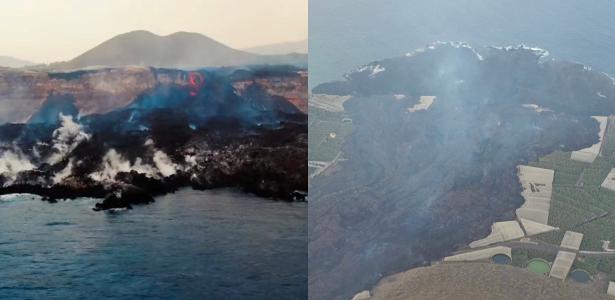
A Lava do Valco Cumbre Vieja It is rapidly entering the Atlantic Ocean, and its accumulation has formed an oceanic delta that has already reached more than 500 m offshore.
In geography, a delta is formed by the accumulation of sediment from a river in the ocean, in a triangular shape. In the case of marine deltas in the Canary Islands, the sediment is volcanic lava that descends from the volcano to the coast through a crack in the surface of its cone.
This crack made of lava is about 30 meters deep in the sea. According to Radio Televisao Canaria, the already formed delta covers an area of 36 hectares and extends 540 meters from the coast to the sea.
A video recorded by a drone from ICMAN (Institute of Marine Sciences of Andalusia) and published by Spain’s CSIC (Superior Council for Scientific Investigation) shows accumulations of delta-forming lava as they emerge gas cloud Due to volcanic material coming into contact with sea water.
The head of volcano monitoring at the National Geographic Institute of Spain, Carmen López, explained that the gaseous emissions are caused by the thermal contrast between the lava and the ocean and are composed of water vapor and hydrochloric acid. According to the expert, such emissions affect only the contact area, although he warned that the surrounding population should be informed about the change in wind.
From another angle, firefighters from the Canary Islands also recorded a lava delta. They do the work of checking the affected roofs and houses. volcanic lava already Over 1,000 buildings affected. Check out the video below.
sulphur dioxide
The Involcan (Canary Islands Volcanoes Institute) reported today that the Cambre Vieja volcano has emitted about 250,000 tons of sulfur dioxide (SO2) since September 19, when it erupted.
The estimate is based on measurements of SO2 emissions in land mobile conditions, which currently have “significant limitations due to several factors”.
Despite this, the agency says that knowing the level of sulfur dioxide emitted also makes it possible to estimate the amount of lava ejected from the Cambre Vieja eruption, which is about 35 million cubic meters.
The Scientific Committee advising the Canary Islands Volcanic Emergency Plan calculated a few days ago that the amount of material emitted by the volcano, which would include pyroclasts, was about 80 million cubic metres. In other words, the damage so far may have been less than imagined.
*With EFE information



